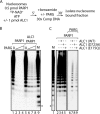Activation of the SNF2 family ATPase ALC1 by poly(ADP-ribose) in a stable ALC1·PARP1·nucleosome intermediate
- PMID: 23132853
- PMCID: PMC3527939
- DOI: 10.1074/jbc.M112.401141
Activation of the SNF2 family ATPase ALC1 by poly(ADP-ribose) in a stable ALC1·PARP1·nucleosome intermediate
Abstract
The human ALC1/CHD1L oncogene encodes an SNF2 family ATPase with a macrodomain that binds poly(ADP-ribose) (PAR). We and others previously showed that ALC1 possesses a cryptic ATP-dependent nucleosome remodeling activity that is potently activated in the presence of PARP1 and NAD(+), its substrate for PAR synthesis. In this work, we dissected the mechanism by which PARP1 and NAD(+) activate ALC1 nucleosome remodeling. We demonstrate that ALC1 activation depends on the formation of a stable ALC1·PARylated PARP1·nucleosome intermediate. In addition, by exploiting a novel PAR footprinting assay, we obtained evidence that the ALC1 macrodomain remains stably associated with PAR on autoPARylated PARP1 during the course of nucleosome remodeling reactions. Taken together, our findings are consistent with the model that PAR present on PARylated PARP1 acts as an allosteric effector of ALC1 nucleosome remodeling activity.
Figures




References
-
- Ma N. F., Hu L., Fung J. M., Xie D., Zheng B. J., Chen L., Tang D. J., Fu L., Wu Z., Chen M., Fang Y., Guan X. Y. (2008) Isolation and characterization of a novel oncogene, amplified in liver cancer 1, within a commonly amplified region at 1q21 in hepatocellular carcinoma. Hepatology 47, 503–510 - PubMed
-
- Brockschmidt A., Chung B., Weber S., Fischer D. C., Kolatsi-Joannou M., Christ L., Heimbach A., Shtiza D., Klaus G., Simonetti G. D., Konrad M., Winyard P., Haffner D., Schaefer F., Weber R. G. (2012) CHD1L: a new candidate gene for congenital anomalies of the kidneys and urinary tract (CAKUT). Nephrol. Dial. Transplant. 27, 2355–2364 - PubMed
-
- Chen L., Chan T. H., Yuan Y. F., Hu L., Huang J., Ma S., Wang J., Dong S. S., Tang K. H., Xie D., Li Y., Guan X. Y. (2010) CHD1L promotes hepatocellular carcinoma progression and metastasis in mice and is associated with these processes in human patients. J. Clin. Invest. 120, 1178–1191 - PMC - PubMed
Publication types
MeSH terms
Substances
Grants and funding
LinkOut - more resources
Full Text Sources
Miscellaneous

